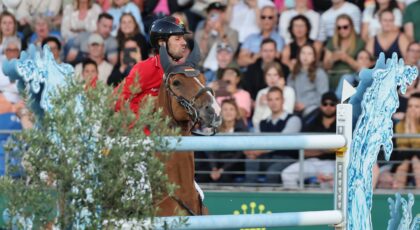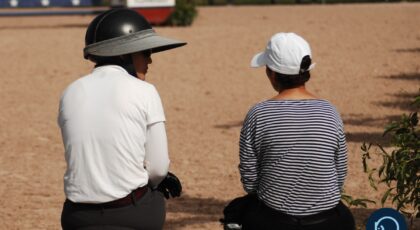True, my young Warmblood, is trotting individual ground poles and sequences of up to four poles in a row, in both directions at various locations around the arena by now.
It’s great to ask your green bean to work poles out in a field, too, as long as the footing is level.
True also trots individual and sequential poles set between two standards but lying on the ground. He doesn’t touch the poles; he remains straight and centered without reminders from me; he maintains a steady pace through approach, poles, and exit; and he stays calm and relaxed.
That’s what we want.
If you notice small problems as you train your baby to negotiate ground poles, now is the time to correct them. Don’t wait till the poles are three feet high, and then realize that the horse is bulging into your left leg or pulling at the bit.
I love True dearly, but he’s no Wonder Horse—he’s at an advantage because he’s being TAUGHT gradually how to perform these tasks instead of expected to figure them out. Teach your little fellas or fillies the same way, and they’ll master this too.
OK, once you’ve got the basic poles down pat, it’s time for crosspoles. Yay!
For this, you need level cushioned footing to reduce the bone and tendon stress of concussion when your little friend lands on her front legs. You also need two standards and four poles, all in colors that do not blend with the background. In other words, don’t trick your baby with red or green poles set on grass or tan poles set on sand. They’re hard for her to see.
Select a quiet location with a long straight approach and exit. Babies need to see obstacles from a distance, without curving approaches or short exits. We want youngsters to feel there’s plenty of space before, after, and to the sides of each jump. Set a very low crosspole in this location.
I start with each jump cup set at about 12” of height. Each of two poles angles downward from the cups, to form a very low X in the center, maybe 6” off the ground. Be sure your poles will fall freely off the standards if the horse bumps them. We want to set the crosspole for success, so your young horse can learn with good opportunities for reward.
This hop is so low the horse can step over it—he doesn’t need to actually jump off his hind feet yet. Add a ground pole touching the X on both sides, to give the horse a visual aid for distance.
Approaching this tiny crosspole, I focus on maintaining the same steady pace, straight centered approach, and calmness that True has learned for ground poles. He responds well, trotting up and hopping over. He hops even though he doesn’t need to. After a few tries back and forth, he learns there is no need to jump the crosspole; he can simply step over it one foot at a time. That’s an important lesson for this particular horse.
For most horses, I raise the crosspole a few inches after only three or four successful efforts on the tiny beginner hop, so they learn to jump over instead of stepping over. This is especially true for horses I am retraining from ranch or trail work in which they learned to step slowly over 2’ poles or branches one foot at a time.
But you’ll recall from my article a few weeks ago that True has a tendency to stand back, look down at a jump, crack his back, and LEAP to high heavens over a single pole raised off the dirt by only 3”.
So, for True, I stick with the tiny crosspole for several days. I’m not drilling, because that’s not the most effective way for a horse’s brain to learn. So when I say that we work on this hop for “several days,” please note that each try is interspersed with many other tasks that he knows but needs to practice—canter departs, rounding, halting, backing, figure eights, transitions, bending around my leg, passing scary locations in the arena, behaving well with other horses nearby, and so on.
When True consistently trots the tiny X one foot at a time, I raise the crosspoles a few inches. With a helper on the ground, you can easily trot your baby back and forth at the 12” cup height, then raise the cups by 3”, successively jumping back and forth with each increase.
Soon, you’ll have the cups at about 24”, making the center of the X about a foot above the ground. Your horse will jump off her hind feet to clear the fence. She’s jumping!
Don’t go past a 24” cup height for crosspoles at this early stage, but feel free to change the location, pole colors, or direction of approach on a random basis. (If you’re riding a pony, reduce maximum cup height accordingly.)
Remain alert for small things that might go wrong. We don’t want babies to get inconsistent in their trot pace or nervous on the approach or exit from a jump. They shouldn’t be drifting to either side. They definitely should not be stopping or trying to evade a crosspole.
If any of these things begin to occur, go back to an easier step. Take it easy, a little bit every other day, with lots of non-edible rewards for good behavior.
Every horse is unique and must be trained according to his own temperament and tendencies. This is one of the hardest training lessons to learn. We tend to assume there must be a way—One Right Way—to train horses. But in fact, there are many ways, depending on the particular horse-and-human team.
True spends a lot of time stepping over low jumps from a walk because he is so exuberant about being airborne. Another horse might never be asked to walk over a low jump, because she needs to become animated enough to pick up her feet and fly a little.
Pack a bunch of training tools in your kit, then select the ones your particular horse needs.
Related reading:
Brain-Based Horsemanship is a weekly column that chronicles Janet Jones, PhD, and her journey with True, a Dutch Warmblood she trained from age three using neuroscience best practices. Read more about brain-based training in Jones’ award winning book Horse Brain, Human Brain.

A version of this story originally appeared on janet-jones.com. It is reprinted here with permission.


 November 1, 2023
November 1, 2023 

























